Reflective Journal on Working Across Cultures: MBA 6150
VerifiedAdded on 2022/09/14
|12
|3052
|17
Journal and Reflective Writing
AI Summary
This reflective journal explores the author's learning journey in a course focused on working across cultures, analyzing intercultural communication through various models and frameworks. The journal examines the impact of culture on communication, discussing elements like body language, tone, and soft skills. It delves into the imperatives of intercultural communication, including self-awareness, demographic, technological, economic, peace, and ethical considerations. The author reflects on contrasting cultural values, the experience of cultural shock, and the stages of adjustment. Furthermore, the journal addresses the influence of language and communication patterns, highlighting the importance of understanding and adapting to different cultural norms. The author shares personal experiences and insights, demonstrating growth in self-awareness and communication skills while navigating the challenges of a multicultural environment.
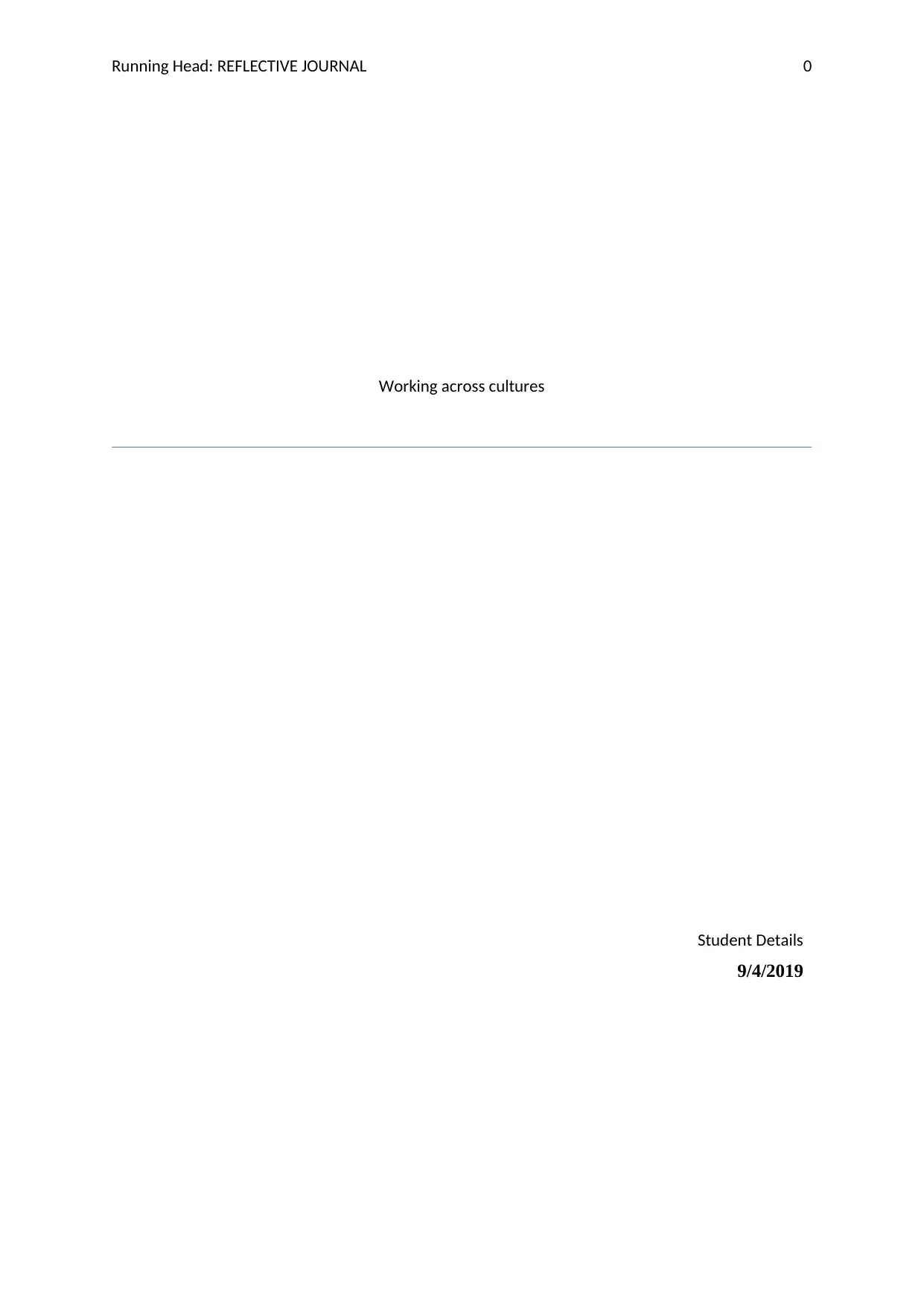
Running Head: REFLECTIVE JOURNAL 0
Working across cultures
Student Details
9/4/2019
Working across cultures
Student Details
9/4/2019
Paraphrase This Document
Need a fresh take? Get an instant paraphrase of this document with our AI Paraphraser
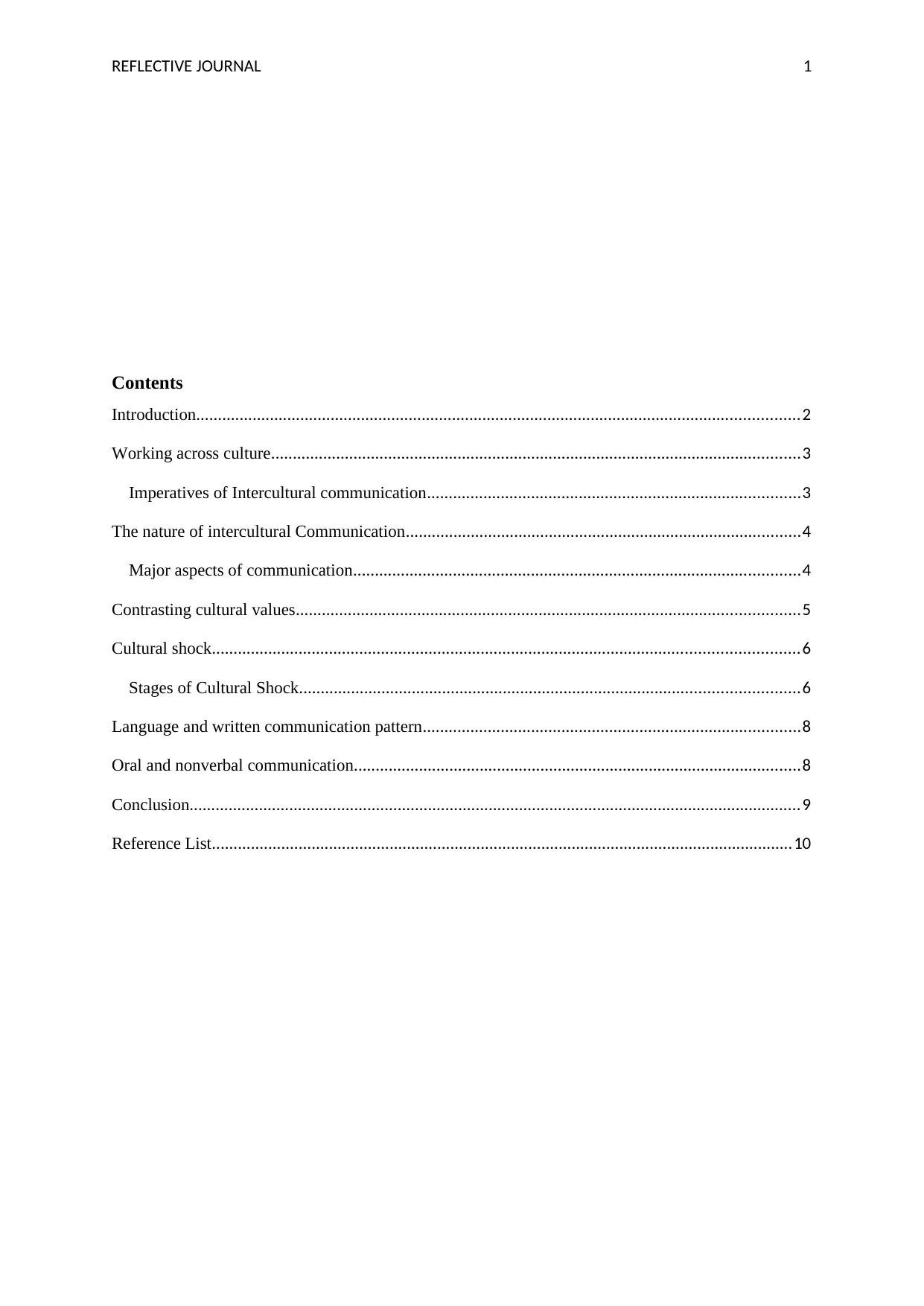
REFLECTIVE JOURNAL 1
Contents
Introduction...........................................................................................................................................2
Working across culture..........................................................................................................................3
Imperatives of Intercultural communication......................................................................................3
The nature of intercultural Communication...........................................................................................4
Major aspects of communication.......................................................................................................4
Contrasting cultural values....................................................................................................................5
Cultural shock.......................................................................................................................................6
Stages of Cultural Shock...................................................................................................................6
Language and written communication pattern.......................................................................................8
Oral and nonverbal communication.......................................................................................................8
Conclusion.............................................................................................................................................9
Reference List......................................................................................................................................10
Contents
Introduction...........................................................................................................................................2
Working across culture..........................................................................................................................3
Imperatives of Intercultural communication......................................................................................3
The nature of intercultural Communication...........................................................................................4
Major aspects of communication.......................................................................................................4
Contrasting cultural values....................................................................................................................5
Cultural shock.......................................................................................................................................6
Stages of Cultural Shock...................................................................................................................6
Language and written communication pattern.......................................................................................8
Oral and nonverbal communication.......................................................................................................8
Conclusion.............................................................................................................................................9
Reference List......................................................................................................................................10
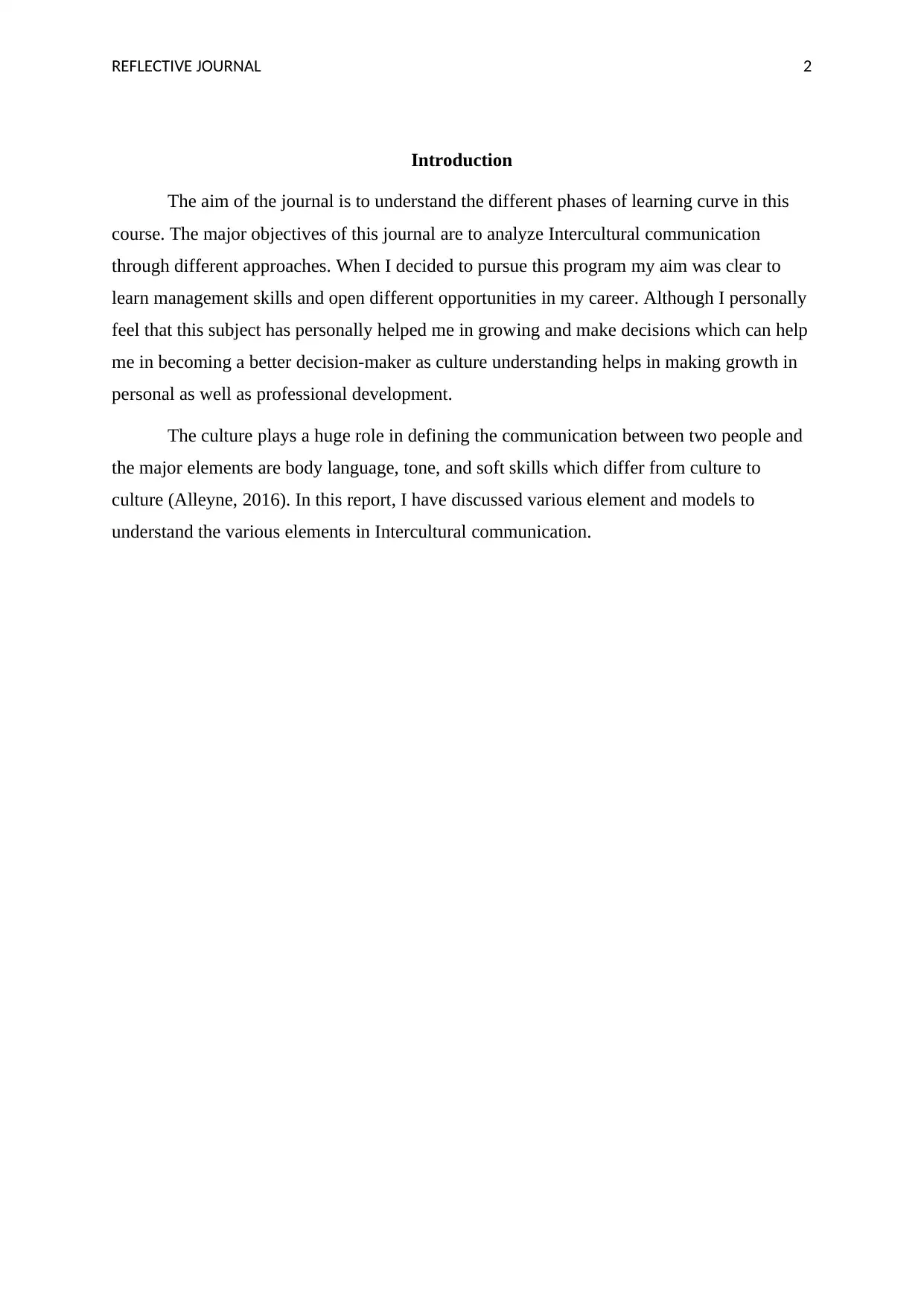
REFLECTIVE JOURNAL 2
Introduction
The aim of the journal is to understand the different phases of learning curve in this
course. The major objectives of this journal are to analyze Intercultural communication
through different approaches. When I decided to pursue this program my aim was clear to
learn management skills and open different opportunities in my career. Although I personally
feel that this subject has personally helped me in growing and make decisions which can help
me in becoming a better decision-maker as culture understanding helps in making growth in
personal as well as professional development.
The culture plays a huge role in defining the communication between two people and
the major elements are body language, tone, and soft skills which differ from culture to
culture (Alleyne, 2016). In this report, I have discussed various element and models to
understand the various elements in Intercultural communication.
Introduction
The aim of the journal is to understand the different phases of learning curve in this
course. The major objectives of this journal are to analyze Intercultural communication
through different approaches. When I decided to pursue this program my aim was clear to
learn management skills and open different opportunities in my career. Although I personally
feel that this subject has personally helped me in growing and make decisions which can help
me in becoming a better decision-maker as culture understanding helps in making growth in
personal as well as professional development.
The culture plays a huge role in defining the communication between two people and
the major elements are body language, tone, and soft skills which differ from culture to
culture (Alleyne, 2016). In this report, I have discussed various element and models to
understand the various elements in Intercultural communication.
⊘ This is a preview!⊘
Do you want full access?
Subscribe today to unlock all pages.

Trusted by 1+ million students worldwide
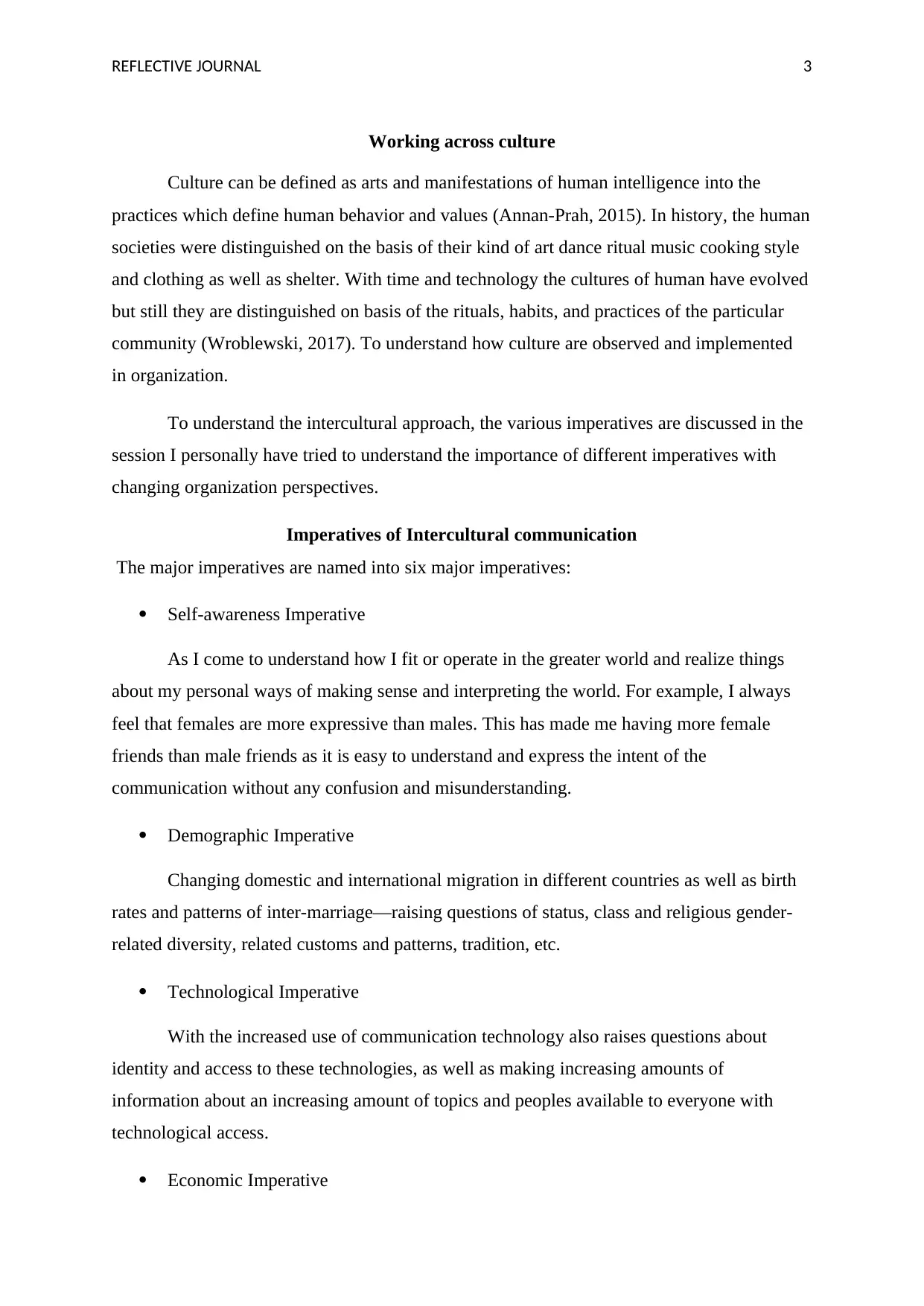
REFLECTIVE JOURNAL 3
Working across culture
Culture can be defined as arts and manifestations of human intelligence into the
practices which define human behavior and values (Annan-Prah, 2015). In history, the human
societies were distinguished on the basis of their kind of art dance ritual music cooking style
and clothing as well as shelter. With time and technology the cultures of human have evolved
but still they are distinguished on basis of the rituals, habits, and practices of the particular
community (Wroblewski, 2017). To understand how culture are observed and implemented
in organization.
To understand the intercultural approach, the various imperatives are discussed in the
session I personally have tried to understand the importance of different imperatives with
changing organization perspectives.
Imperatives of Intercultural communication
The major imperatives are named into six major imperatives:
Self-awareness Imperative
As I come to understand how I fit or operate in the greater world and realize things
about my personal ways of making sense and interpreting the world. For example, I always
feel that females are more expressive than males. This has made me having more female
friends than male friends as it is easy to understand and express the intent of the
communication without any confusion and misunderstanding.
Demographic Imperative
Changing domestic and international migration in different countries as well as birth
rates and patterns of inter-marriage—raising questions of status, class and religious gender-
related diversity, related customs and patterns, tradition, etc.
Technological Imperative
With the increased use of communication technology also raises questions about
identity and access to these technologies, as well as making increasing amounts of
information about an increasing amount of topics and peoples available to everyone with
technological access.
Economic Imperative
Working across culture
Culture can be defined as arts and manifestations of human intelligence into the
practices which define human behavior and values (Annan-Prah, 2015). In history, the human
societies were distinguished on the basis of their kind of art dance ritual music cooking style
and clothing as well as shelter. With time and technology the cultures of human have evolved
but still they are distinguished on basis of the rituals, habits, and practices of the particular
community (Wroblewski, 2017). To understand how culture are observed and implemented
in organization.
To understand the intercultural approach, the various imperatives are discussed in the
session I personally have tried to understand the importance of different imperatives with
changing organization perspectives.
Imperatives of Intercultural communication
The major imperatives are named into six major imperatives:
Self-awareness Imperative
As I come to understand how I fit or operate in the greater world and realize things
about my personal ways of making sense and interpreting the world. For example, I always
feel that females are more expressive than males. This has made me having more female
friends than male friends as it is easy to understand and express the intent of the
communication without any confusion and misunderstanding.
Demographic Imperative
Changing domestic and international migration in different countries as well as birth
rates and patterns of inter-marriage—raising questions of status, class and religious gender-
related diversity, related customs and patterns, tradition, etc.
Technological Imperative
With the increased use of communication technology also raises questions about
identity and access to these technologies, as well as making increasing amounts of
information about an increasing amount of topics and peoples available to everyone with
technological access.
Economic Imperative
Paraphrase This Document
Need a fresh take? Get an instant paraphrase of this document with our AI Paraphraser
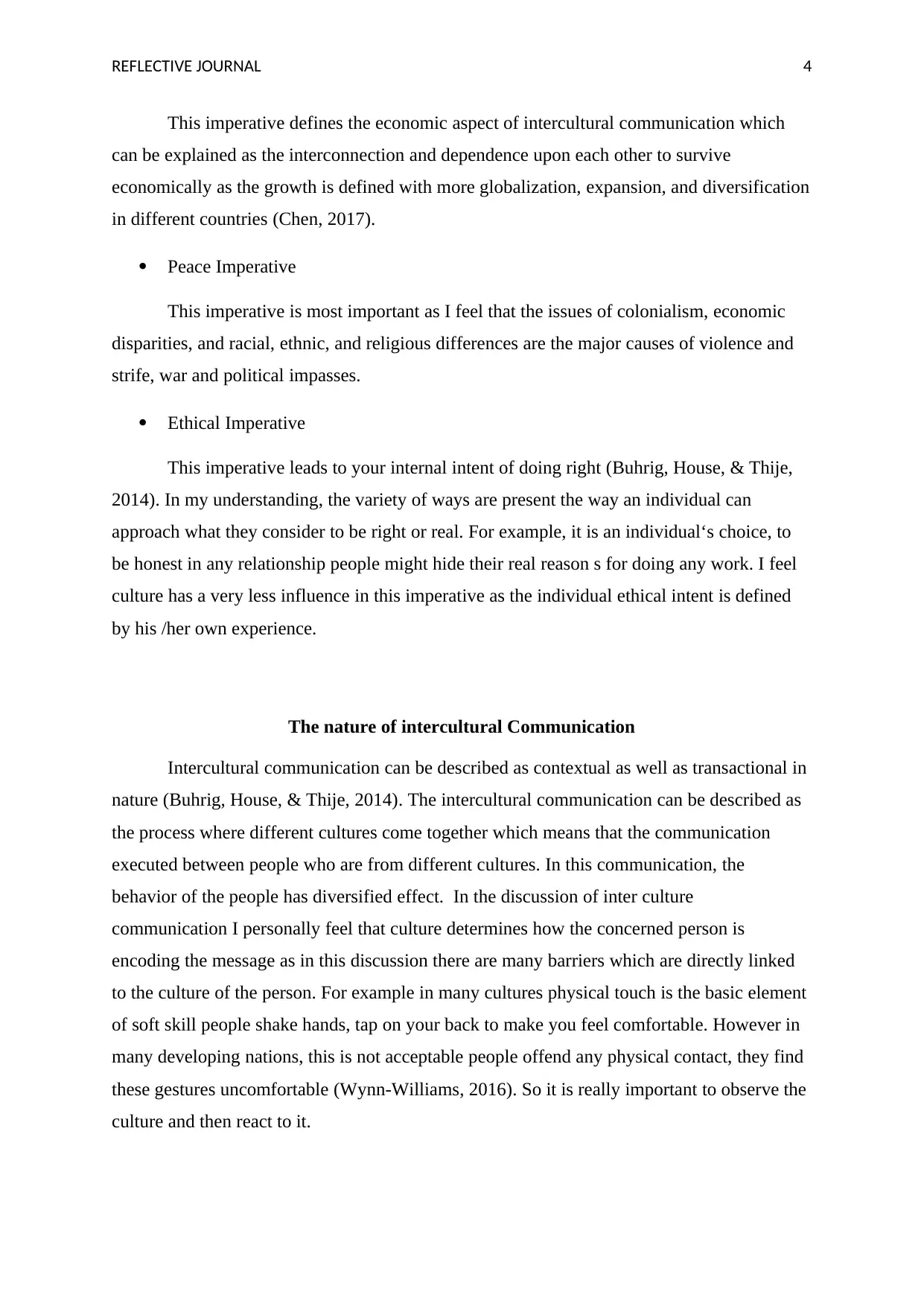
REFLECTIVE JOURNAL 4
This imperative defines the economic aspect of intercultural communication which
can be explained as the interconnection and dependence upon each other to survive
economically as the growth is defined with more globalization, expansion, and diversification
in different countries (Chen, 2017).
Peace Imperative
This imperative is most important as I feel that the issues of colonialism, economic
disparities, and racial, ethnic, and religious differences are the major causes of violence and
strife, war and political impasses.
Ethical Imperative
This imperative leads to your internal intent of doing right (Buhrig, House, & Thije,
2014). In my understanding, the variety of ways are present the way an individual can
approach what they consider to be right or real. For example, it is an individual‘s choice, to
be honest in any relationship people might hide their real reason s for doing any work. I feel
culture has a very less influence in this imperative as the individual ethical intent is defined
by his /her own experience.
The nature of intercultural Communication
Intercultural communication can be described as contextual as well as transactional in
nature (Buhrig, House, & Thije, 2014). The intercultural communication can be described as
the process where different cultures come together which means that the communication
executed between people who are from different cultures. In this communication, the
behavior of the people has diversified effect. In the discussion of inter culture
communication I personally feel that culture determines how the concerned person is
encoding the message as in this discussion there are many barriers which are directly linked
to the culture of the person. For example in many cultures physical touch is the basic element
of soft skill people shake hands, tap on your back to make you feel comfortable. However in
many developing nations, this is not acceptable people offend any physical contact, they find
these gestures uncomfortable (Wynn-Williams, 2016). So it is really important to observe the
culture and then react to it.
This imperative defines the economic aspect of intercultural communication which
can be explained as the interconnection and dependence upon each other to survive
economically as the growth is defined with more globalization, expansion, and diversification
in different countries (Chen, 2017).
Peace Imperative
This imperative is most important as I feel that the issues of colonialism, economic
disparities, and racial, ethnic, and religious differences are the major causes of violence and
strife, war and political impasses.
Ethical Imperative
This imperative leads to your internal intent of doing right (Buhrig, House, & Thije,
2014). In my understanding, the variety of ways are present the way an individual can
approach what they consider to be right or real. For example, it is an individual‘s choice, to
be honest in any relationship people might hide their real reason s for doing any work. I feel
culture has a very less influence in this imperative as the individual ethical intent is defined
by his /her own experience.
The nature of intercultural Communication
Intercultural communication can be described as contextual as well as transactional in
nature (Buhrig, House, & Thije, 2014). The intercultural communication can be described as
the process where different cultures come together which means that the communication
executed between people who are from different cultures. In this communication, the
behavior of the people has diversified effect. In the discussion of inter culture
communication I personally feel that culture determines how the concerned person is
encoding the message as in this discussion there are many barriers which are directly linked
to the culture of the person. For example in many cultures physical touch is the basic element
of soft skill people shake hands, tap on your back to make you feel comfortable. However in
many developing nations, this is not acceptable people offend any physical contact, they find
these gestures uncomfortable (Wynn-Williams, 2016). So it is really important to observe the
culture and then react to it.
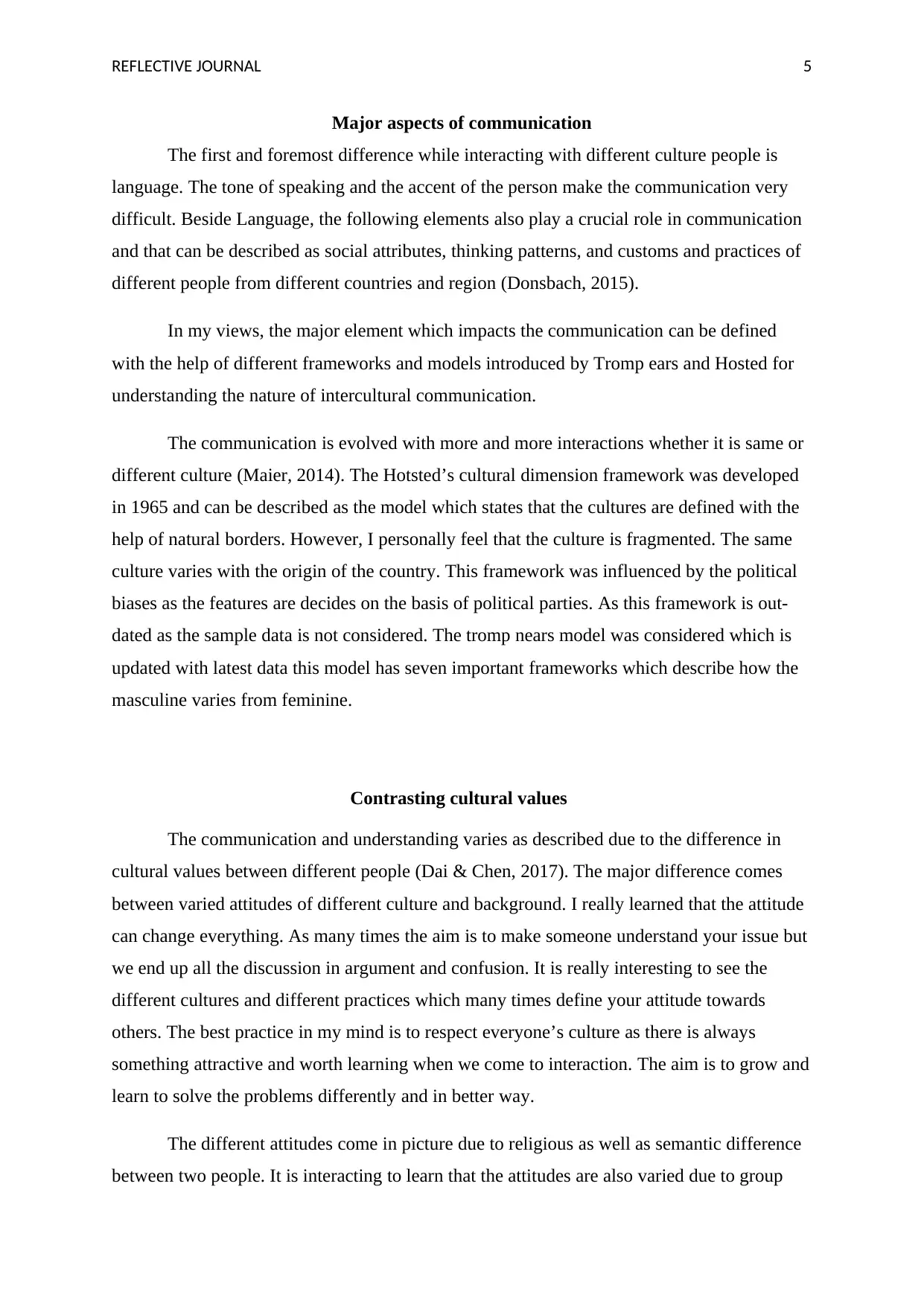
REFLECTIVE JOURNAL 5
Major aspects of communication
The first and foremost difference while interacting with different culture people is
language. The tone of speaking and the accent of the person make the communication very
difficult. Beside Language, the following elements also play a crucial role in communication
and that can be described as social attributes, thinking patterns, and customs and practices of
different people from different countries and region (Donsbach, 2015).
In my views, the major element which impacts the communication can be defined
with the help of different frameworks and models introduced by Tromp ears and Hosted for
understanding the nature of intercultural communication.
The communication is evolved with more and more interactions whether it is same or
different culture (Maier, 2014). The Hotsted’s cultural dimension framework was developed
in 1965 and can be described as the model which states that the cultures are defined with the
help of natural borders. However, I personally feel that the culture is fragmented. The same
culture varies with the origin of the country. This framework was influenced by the political
biases as the features are decides on the basis of political parties. As this framework is out-
dated as the sample data is not considered. The tromp nears model was considered which is
updated with latest data this model has seven important frameworks which describe how the
masculine varies from feminine.
Contrasting cultural values
The communication and understanding varies as described due to the difference in
cultural values between different people (Dai & Chen, 2017). The major difference comes
between varied attitudes of different culture and background. I really learned that the attitude
can change everything. As many times the aim is to make someone understand your issue but
we end up all the discussion in argument and confusion. It is really interesting to see the
different cultures and different practices which many times define your attitude towards
others. The best practice in my mind is to respect everyone’s culture as there is always
something attractive and worth learning when we come to interaction. The aim is to grow and
learn to solve the problems differently and in better way.
The different attitudes come in picture due to religious as well as semantic difference
between two people. It is interacting to learn that the attitudes are also varied due to group
Major aspects of communication
The first and foremost difference while interacting with different culture people is
language. The tone of speaking and the accent of the person make the communication very
difficult. Beside Language, the following elements also play a crucial role in communication
and that can be described as social attributes, thinking patterns, and customs and practices of
different people from different countries and region (Donsbach, 2015).
In my views, the major element which impacts the communication can be defined
with the help of different frameworks and models introduced by Tromp ears and Hosted for
understanding the nature of intercultural communication.
The communication is evolved with more and more interactions whether it is same or
different culture (Maier, 2014). The Hotsted’s cultural dimension framework was developed
in 1965 and can be described as the model which states that the cultures are defined with the
help of natural borders. However, I personally feel that the culture is fragmented. The same
culture varies with the origin of the country. This framework was influenced by the political
biases as the features are decides on the basis of political parties. As this framework is out-
dated as the sample data is not considered. The tromp nears model was considered which is
updated with latest data this model has seven important frameworks which describe how the
masculine varies from feminine.
Contrasting cultural values
The communication and understanding varies as described due to the difference in
cultural values between different people (Dai & Chen, 2017). The major difference comes
between varied attitudes of different culture and background. I really learned that the attitude
can change everything. As many times the aim is to make someone understand your issue but
we end up all the discussion in argument and confusion. It is really interesting to see the
different cultures and different practices which many times define your attitude towards
others. The best practice in my mind is to respect everyone’s culture as there is always
something attractive and worth learning when we come to interaction. The aim is to grow and
learn to solve the problems differently and in better way.
The different attitudes come in picture due to religious as well as semantic difference
between two people. It is interacting to learn that the attitudes are also varied due to group
⊘ This is a preview!⊘
Do you want full access?
Subscribe today to unlock all pages.

Trusted by 1+ million students worldwide
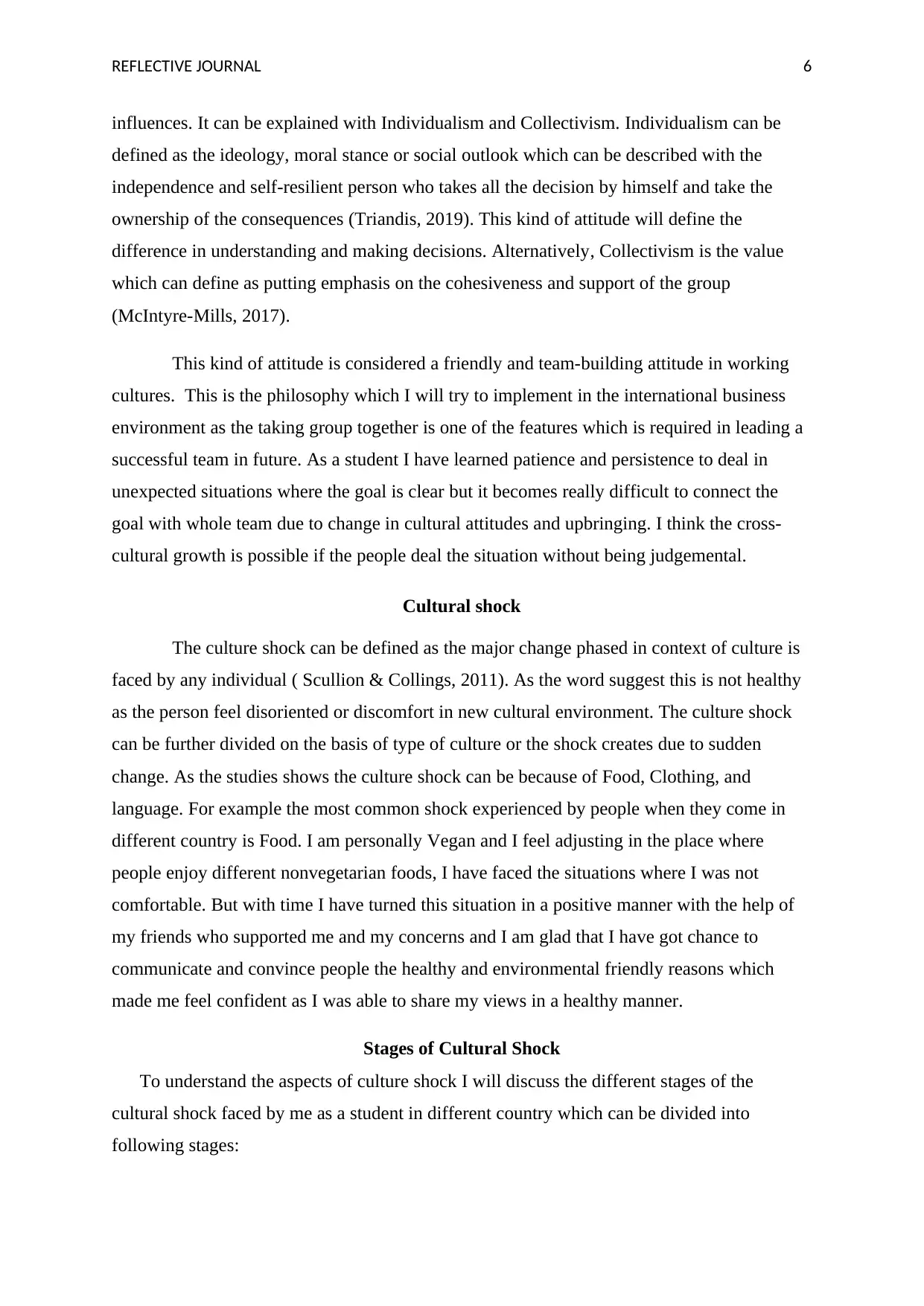
REFLECTIVE JOURNAL 6
influences. It can be explained with Individualism and Collectivism. Individualism can be
defined as the ideology, moral stance or social outlook which can be described with the
independence and self-resilient person who takes all the decision by himself and take the
ownership of the consequences (Triandis, 2019). This kind of attitude will define the
difference in understanding and making decisions. Alternatively, Collectivism is the value
which can define as putting emphasis on the cohesiveness and support of the group
(McIntyre-Mills, 2017).
This kind of attitude is considered a friendly and team-building attitude in working
cultures. This is the philosophy which I will try to implement in the international business
environment as the taking group together is one of the features which is required in leading a
successful team in future. As a student I have learned patience and persistence to deal in
unexpected situations where the goal is clear but it becomes really difficult to connect the
goal with whole team due to change in cultural attitudes and upbringing. I think the cross-
cultural growth is possible if the people deal the situation without being judgemental.
Cultural shock
The culture shock can be defined as the major change phased in context of culture is
faced by any individual ( Scullion & Collings, 2011). As the word suggest this is not healthy
as the person feel disoriented or discomfort in new cultural environment. The culture shock
can be further divided on the basis of type of culture or the shock creates due to sudden
change. As the studies shows the culture shock can be because of Food, Clothing, and
language. For example the most common shock experienced by people when they come in
different country is Food. I am personally Vegan and I feel adjusting in the place where
people enjoy different nonvegetarian foods, I have faced the situations where I was not
comfortable. But with time I have turned this situation in a positive manner with the help of
my friends who supported me and my concerns and I am glad that I have got chance to
communicate and convince people the healthy and environmental friendly reasons which
made me feel confident as I was able to share my views in a healthy manner.
Stages of Cultural Shock
To understand the aspects of culture shock I will discuss the different stages of the
cultural shock faced by me as a student in different country which can be divided into
following stages:
influences. It can be explained with Individualism and Collectivism. Individualism can be
defined as the ideology, moral stance or social outlook which can be described with the
independence and self-resilient person who takes all the decision by himself and take the
ownership of the consequences (Triandis, 2019). This kind of attitude will define the
difference in understanding and making decisions. Alternatively, Collectivism is the value
which can define as putting emphasis on the cohesiveness and support of the group
(McIntyre-Mills, 2017).
This kind of attitude is considered a friendly and team-building attitude in working
cultures. This is the philosophy which I will try to implement in the international business
environment as the taking group together is one of the features which is required in leading a
successful team in future. As a student I have learned patience and persistence to deal in
unexpected situations where the goal is clear but it becomes really difficult to connect the
goal with whole team due to change in cultural attitudes and upbringing. I think the cross-
cultural growth is possible if the people deal the situation without being judgemental.
Cultural shock
The culture shock can be defined as the major change phased in context of culture is
faced by any individual ( Scullion & Collings, 2011). As the word suggest this is not healthy
as the person feel disoriented or discomfort in new cultural environment. The culture shock
can be further divided on the basis of type of culture or the shock creates due to sudden
change. As the studies shows the culture shock can be because of Food, Clothing, and
language. For example the most common shock experienced by people when they come in
different country is Food. I am personally Vegan and I feel adjusting in the place where
people enjoy different nonvegetarian foods, I have faced the situations where I was not
comfortable. But with time I have turned this situation in a positive manner with the help of
my friends who supported me and my concerns and I am glad that I have got chance to
communicate and convince people the healthy and environmental friendly reasons which
made me feel confident as I was able to share my views in a healthy manner.
Stages of Cultural Shock
To understand the aspects of culture shock I will discuss the different stages of the
cultural shock faced by me as a student in different country which can be divided into
following stages:
Paraphrase This Document
Need a fresh take? Get an instant paraphrase of this document with our AI Paraphraser
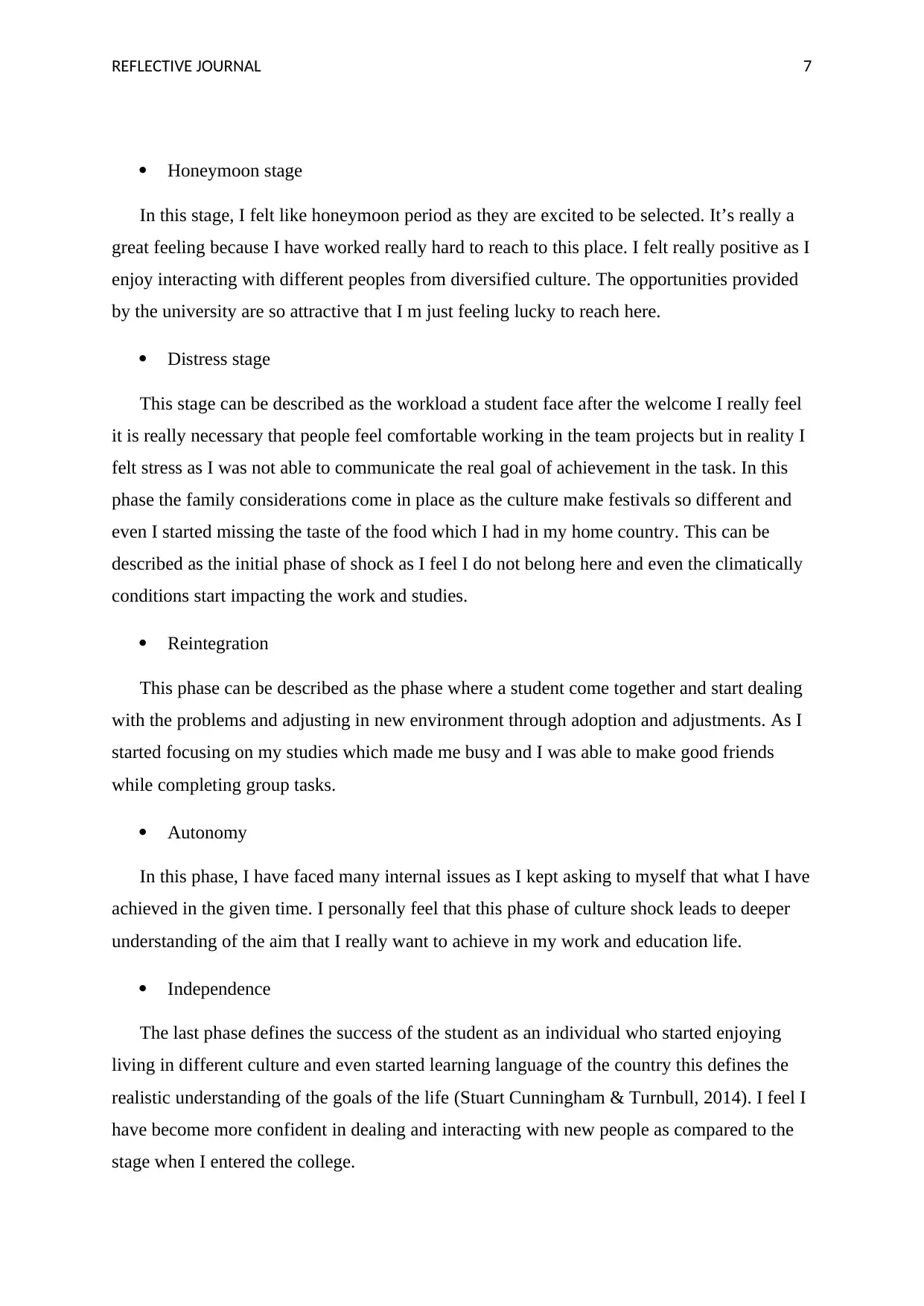
REFLECTIVE JOURNAL 7
Honeymoon stage
In this stage, I felt like honeymoon period as they are excited to be selected. It’s really a
great feeling because I have worked really hard to reach to this place. I felt really positive as I
enjoy interacting with different peoples from diversified culture. The opportunities provided
by the university are so attractive that I m just feeling lucky to reach here.
Distress stage
This stage can be described as the workload a student face after the welcome I really feel
it is really necessary that people feel comfortable working in the team projects but in reality I
felt stress as I was not able to communicate the real goal of achievement in the task. In this
phase the family considerations come in place as the culture make festivals so different and
even I started missing the taste of the food which I had in my home country. This can be
described as the initial phase of shock as I feel I do not belong here and even the climatically
conditions start impacting the work and studies.
Reintegration
This phase can be described as the phase where a student come together and start dealing
with the problems and adjusting in new environment through adoption and adjustments. As I
started focusing on my studies which made me busy and I was able to make good friends
while completing group tasks.
Autonomy
In this phase, I have faced many internal issues as I kept asking to myself that what I have
achieved in the given time. I personally feel that this phase of culture shock leads to deeper
understanding of the aim that I really want to achieve in my work and education life.
Independence
The last phase defines the success of the student as an individual who started enjoying
living in different culture and even started learning language of the country this defines the
realistic understanding of the goals of the life (Stuart Cunningham & Turnbull, 2014). I feel I
have become more confident in dealing and interacting with new people as compared to the
stage when I entered the college.
Honeymoon stage
In this stage, I felt like honeymoon period as they are excited to be selected. It’s really a
great feeling because I have worked really hard to reach to this place. I felt really positive as I
enjoy interacting with different peoples from diversified culture. The opportunities provided
by the university are so attractive that I m just feeling lucky to reach here.
Distress stage
This stage can be described as the workload a student face after the welcome I really feel
it is really necessary that people feel comfortable working in the team projects but in reality I
felt stress as I was not able to communicate the real goal of achievement in the task. In this
phase the family considerations come in place as the culture make festivals so different and
even I started missing the taste of the food which I had in my home country. This can be
described as the initial phase of shock as I feel I do not belong here and even the climatically
conditions start impacting the work and studies.
Reintegration
This phase can be described as the phase where a student come together and start dealing
with the problems and adjusting in new environment through adoption and adjustments. As I
started focusing on my studies which made me busy and I was able to make good friends
while completing group tasks.
Autonomy
In this phase, I have faced many internal issues as I kept asking to myself that what I have
achieved in the given time. I personally feel that this phase of culture shock leads to deeper
understanding of the aim that I really want to achieve in my work and education life.
Independence
The last phase defines the success of the student as an individual who started enjoying
living in different culture and even started learning language of the country this defines the
realistic understanding of the goals of the life (Stuart Cunningham & Turnbull, 2014). I feel I
have become more confident in dealing and interacting with new people as compared to the
stage when I entered the college.
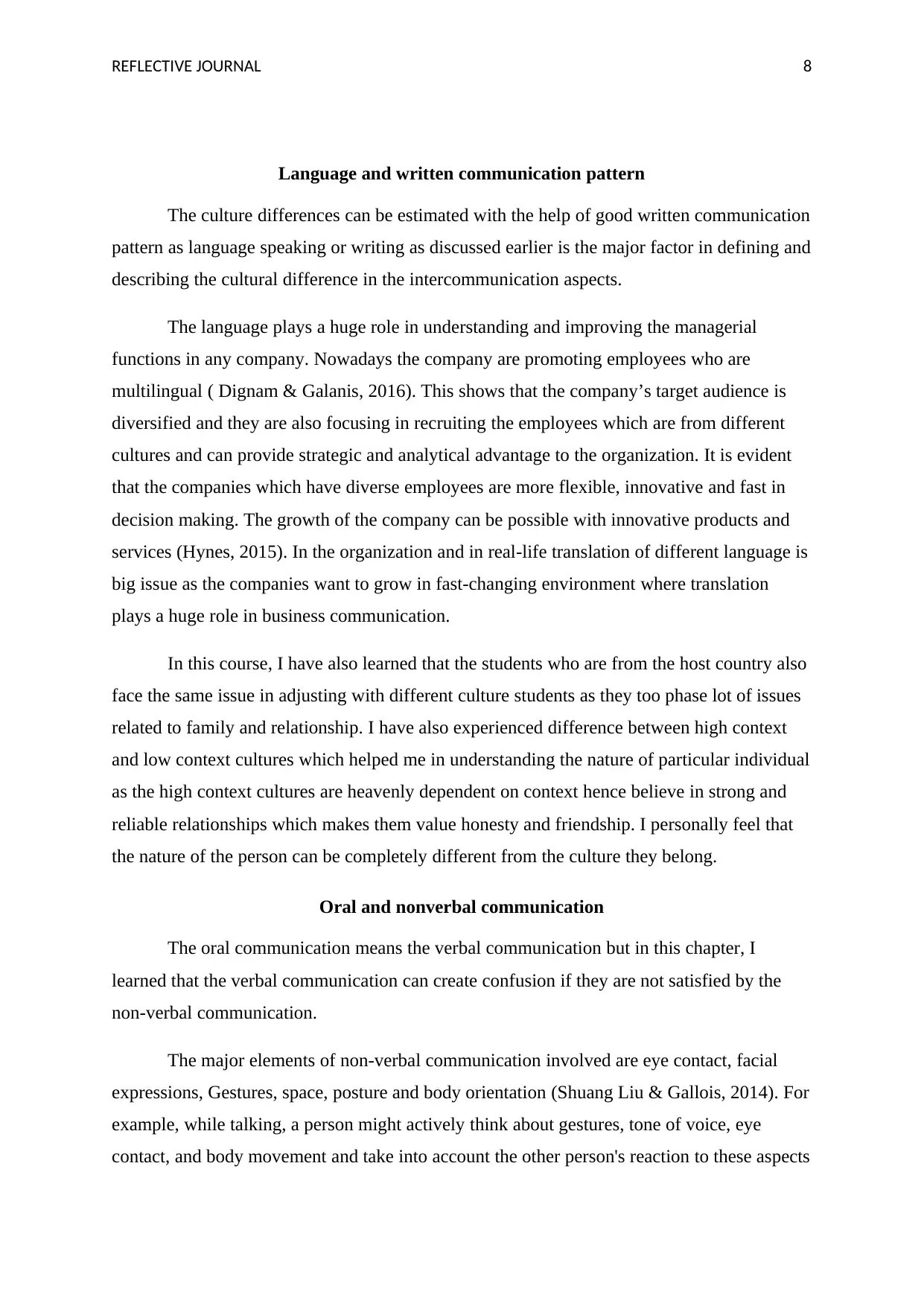
REFLECTIVE JOURNAL 8
Language and written communication pattern
The culture differences can be estimated with the help of good written communication
pattern as language speaking or writing as discussed earlier is the major factor in defining and
describing the cultural difference in the intercommunication aspects.
The language plays a huge role in understanding and improving the managerial
functions in any company. Nowadays the company are promoting employees who are
multilingual ( Dignam & Galanis, 2016). This shows that the company’s target audience is
diversified and they are also focusing in recruiting the employees which are from different
cultures and can provide strategic and analytical advantage to the organization. It is evident
that the companies which have diverse employees are more flexible, innovative and fast in
decision making. The growth of the company can be possible with innovative products and
services (Hynes, 2015). In the organization and in real-life translation of different language is
big issue as the companies want to grow in fast-changing environment where translation
plays a huge role in business communication.
In this course, I have also learned that the students who are from the host country also
face the same issue in adjusting with different culture students as they too phase lot of issues
related to family and relationship. I have also experienced difference between high context
and low context cultures which helped me in understanding the nature of particular individual
as the high context cultures are heavenly dependent on context hence believe in strong and
reliable relationships which makes them value honesty and friendship. I personally feel that
the nature of the person can be completely different from the culture they belong.
Oral and nonverbal communication
The oral communication means the verbal communication but in this chapter, I
learned that the verbal communication can create confusion if they are not satisfied by the
non-verbal communication.
The major elements of non-verbal communication involved are eye contact, facial
expressions, Gestures, space, posture and body orientation (Shuang Liu & Gallois, 2014). For
example, while talking, a person might actively think about gestures, tone of voice, eye
contact, and body movement and take into account the other person's reaction to these aspects
Language and written communication pattern
The culture differences can be estimated with the help of good written communication
pattern as language speaking or writing as discussed earlier is the major factor in defining and
describing the cultural difference in the intercommunication aspects.
The language plays a huge role in understanding and improving the managerial
functions in any company. Nowadays the company are promoting employees who are
multilingual ( Dignam & Galanis, 2016). This shows that the company’s target audience is
diversified and they are also focusing in recruiting the employees which are from different
cultures and can provide strategic and analytical advantage to the organization. It is evident
that the companies which have diverse employees are more flexible, innovative and fast in
decision making. The growth of the company can be possible with innovative products and
services (Hynes, 2015). In the organization and in real-life translation of different language is
big issue as the companies want to grow in fast-changing environment where translation
plays a huge role in business communication.
In this course, I have also learned that the students who are from the host country also
face the same issue in adjusting with different culture students as they too phase lot of issues
related to family and relationship. I have also experienced difference between high context
and low context cultures which helped me in understanding the nature of particular individual
as the high context cultures are heavenly dependent on context hence believe in strong and
reliable relationships which makes them value honesty and friendship. I personally feel that
the nature of the person can be completely different from the culture they belong.
Oral and nonverbal communication
The oral communication means the verbal communication but in this chapter, I
learned that the verbal communication can create confusion if they are not satisfied by the
non-verbal communication.
The major elements of non-verbal communication involved are eye contact, facial
expressions, Gestures, space, posture and body orientation (Shuang Liu & Gallois, 2014). For
example, while talking, a person might actively think about gestures, tone of voice, eye
contact, and body movement and take into account the other person's reaction to these aspects
⊘ This is a preview!⊘
Do you want full access?
Subscribe today to unlock all pages.

Trusted by 1+ million students worldwide
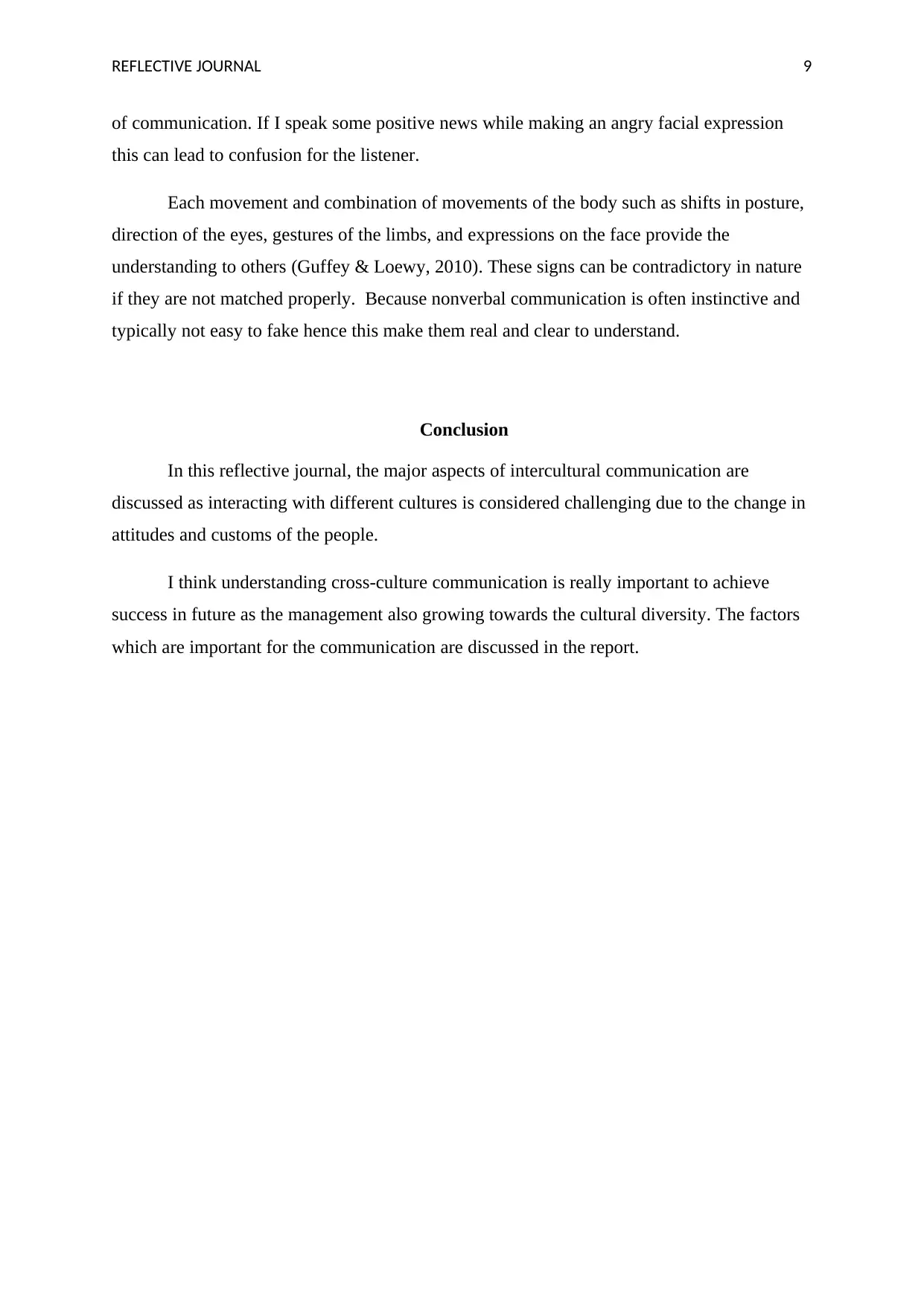
REFLECTIVE JOURNAL 9
of communication. If I speak some positive news while making an angry facial expression
this can lead to confusion for the listener.
Each movement and combination of movements of the body such as shifts in posture,
direction of the eyes, gestures of the limbs, and expressions on the face provide the
understanding to others (Guffey & Loewy, 2010). These signs can be contradictory in nature
if they are not matched properly. Because nonverbal communication is often instinctive and
typically not easy to fake hence this make them real and clear to understand.
Conclusion
In this reflective journal, the major aspects of intercultural communication are
discussed as interacting with different cultures is considered challenging due to the change in
attitudes and customs of the people.
I think understanding cross-culture communication is really important to achieve
success in future as the management also growing towards the cultural diversity. The factors
which are important for the communication are discussed in the report.
of communication. If I speak some positive news while making an angry facial expression
this can lead to confusion for the listener.
Each movement and combination of movements of the body such as shifts in posture,
direction of the eyes, gestures of the limbs, and expressions on the face provide the
understanding to others (Guffey & Loewy, 2010). These signs can be contradictory in nature
if they are not matched properly. Because nonverbal communication is often instinctive and
typically not easy to fake hence this make them real and clear to understand.
Conclusion
In this reflective journal, the major aspects of intercultural communication are
discussed as interacting with different cultures is considered challenging due to the change in
attitudes and customs of the people.
I think understanding cross-culture communication is really important to achieve
success in future as the management also growing towards the cultural diversity. The factors
which are important for the communication are discussed in the report.
Paraphrase This Document
Need a fresh take? Get an instant paraphrase of this document with our AI Paraphraser
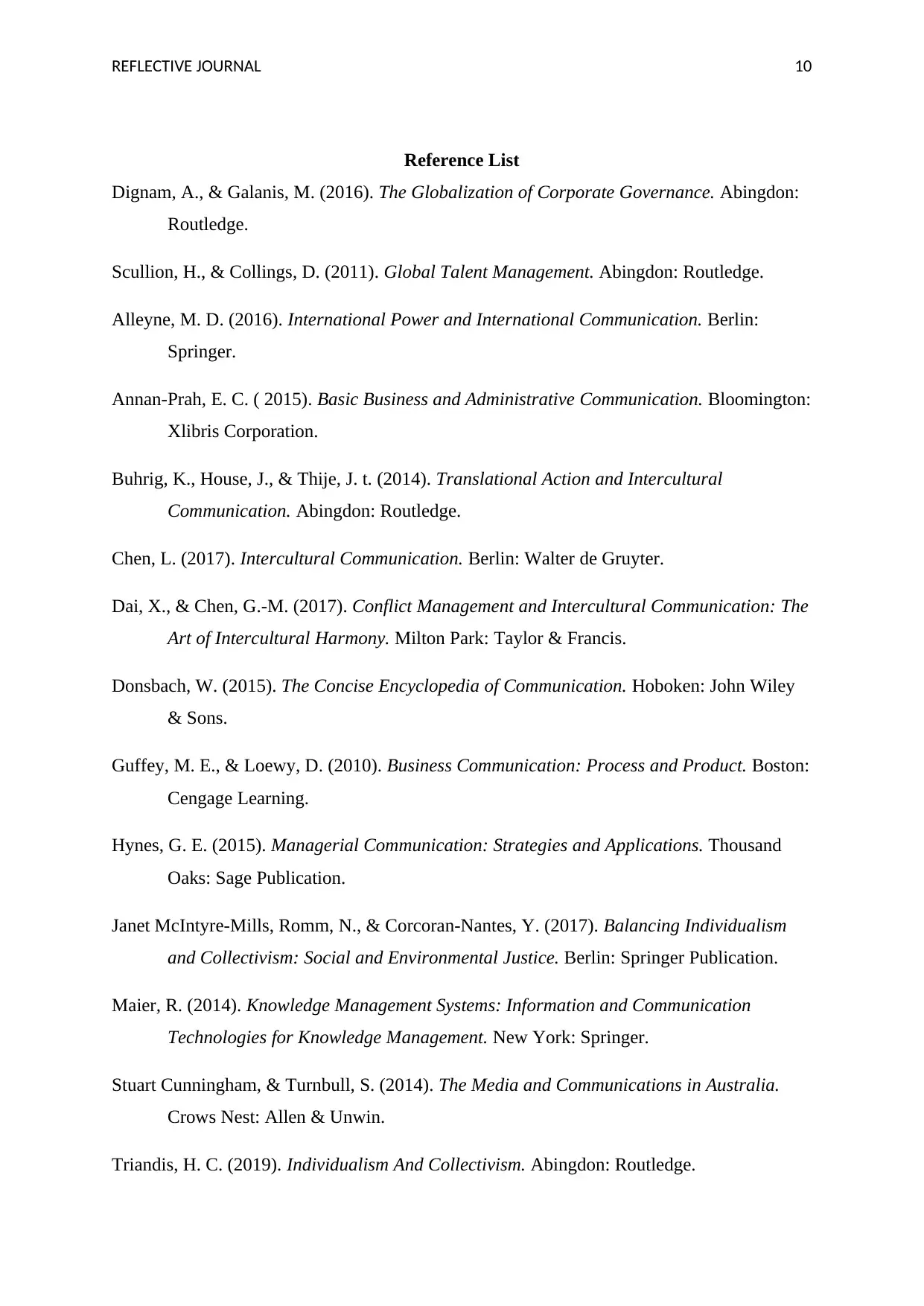
REFLECTIVE JOURNAL 10
Reference List
Dignam, A., & Galanis, M. (2016). The Globalization of Corporate Governance. Abingdon:
Routledge.
Scullion, H., & Collings, D. (2011). Global Talent Management. Abingdon: Routledge.
Alleyne, M. D. (2016). International Power and International Communication. Berlin:
Springer.
Annan-Prah, E. C. ( 2015). Basic Business and Administrative Communication. Bloomington:
Xlibris Corporation.
Buhrig, K., House, J., & Thije, J. t. (2014). Translational Action and Intercultural
Communication. Abingdon: Routledge.
Chen, L. (2017). Intercultural Communication. Berlin: Walter de Gruyter.
Dai, X., & Chen, G.-M. (2017). Conflict Management and Intercultural Communication: The
Art of Intercultural Harmony. Milton Park: Taylor & Francis.
Donsbach, W. (2015). The Concise Encyclopedia of Communication. Hoboken: John Wiley
& Sons.
Guffey, M. E., & Loewy, D. (2010). Business Communication: Process and Product. Boston:
Cengage Learning.
Hynes, G. E. (2015). Managerial Communication: Strategies and Applications. Thousand
Oaks: Sage Publication.
Janet McIntyre-Mills, Romm, N., & Corcoran-Nantes, Y. (2017). Balancing Individualism
and Collectivism: Social and Environmental Justice. Berlin: Springer Publication.
Maier, R. (2014). Knowledge Management Systems: Information and Communication
Technologies for Knowledge Management. New York: Springer.
Stuart Cunningham, & Turnbull, S. (2014). The Media and Communications in Australia.
Crows Nest: Allen & Unwin.
Triandis, H. C. (2019). Individualism And Collectivism. Abingdon: Routledge.
Reference List
Dignam, A., & Galanis, M. (2016). The Globalization of Corporate Governance. Abingdon:
Routledge.
Scullion, H., & Collings, D. (2011). Global Talent Management. Abingdon: Routledge.
Alleyne, M. D. (2016). International Power and International Communication. Berlin:
Springer.
Annan-Prah, E. C. ( 2015). Basic Business and Administrative Communication. Bloomington:
Xlibris Corporation.
Buhrig, K., House, J., & Thije, J. t. (2014). Translational Action and Intercultural
Communication. Abingdon: Routledge.
Chen, L. (2017). Intercultural Communication. Berlin: Walter de Gruyter.
Dai, X., & Chen, G.-M. (2017). Conflict Management and Intercultural Communication: The
Art of Intercultural Harmony. Milton Park: Taylor & Francis.
Donsbach, W. (2015). The Concise Encyclopedia of Communication. Hoboken: John Wiley
& Sons.
Guffey, M. E., & Loewy, D. (2010). Business Communication: Process and Product. Boston:
Cengage Learning.
Hynes, G. E. (2015). Managerial Communication: Strategies and Applications. Thousand
Oaks: Sage Publication.
Janet McIntyre-Mills, Romm, N., & Corcoran-Nantes, Y. (2017). Balancing Individualism
and Collectivism: Social and Environmental Justice. Berlin: Springer Publication.
Maier, R. (2014). Knowledge Management Systems: Information and Communication
Technologies for Knowledge Management. New York: Springer.
Stuart Cunningham, & Turnbull, S. (2014). The Media and Communications in Australia.
Crows Nest: Allen & Unwin.
Triandis, H. C. (2019). Individualism And Collectivism. Abingdon: Routledge.
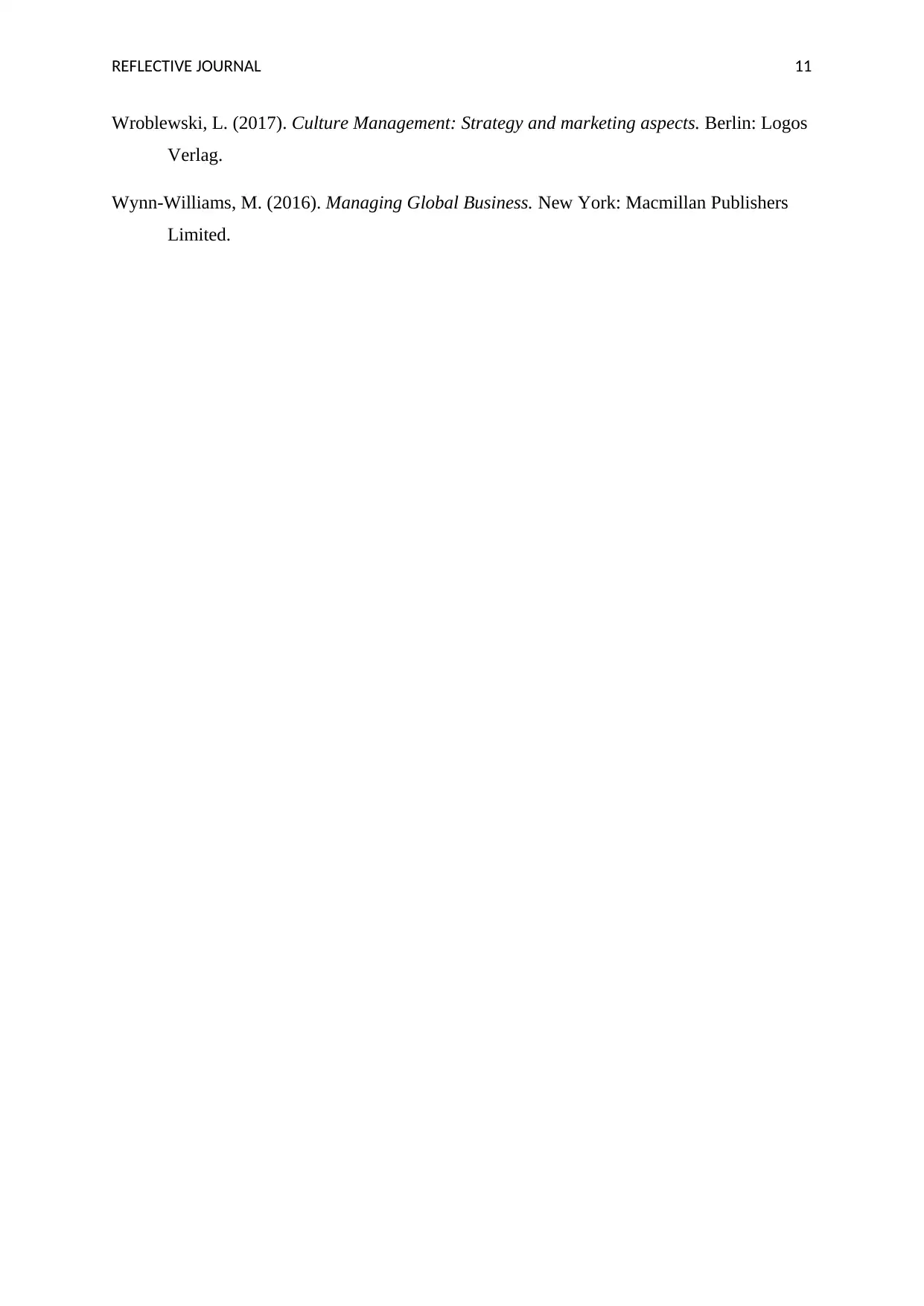
REFLECTIVE JOURNAL 11
Wroblewski, L. (2017). Culture Management: Strategy and marketing aspects. Berlin: Logos
Verlag.
Wynn-Williams, M. (2016). Managing Global Business. New York: Macmillan Publishers
Limited.
Wroblewski, L. (2017). Culture Management: Strategy and marketing aspects. Berlin: Logos
Verlag.
Wynn-Williams, M. (2016). Managing Global Business. New York: Macmillan Publishers
Limited.
⊘ This is a preview!⊘
Do you want full access?
Subscribe today to unlock all pages.

Trusted by 1+ million students worldwide
1 out of 12
Related Documents
Your All-in-One AI-Powered Toolkit for Academic Success.
+13062052269
info@desklib.com
Available 24*7 on WhatsApp / Email
![[object Object]](/_next/static/media/star-bottom.7253800d.svg)
Unlock your academic potential
Copyright © 2020–2025 A2Z Services. All Rights Reserved. Developed and managed by ZUCOL.





